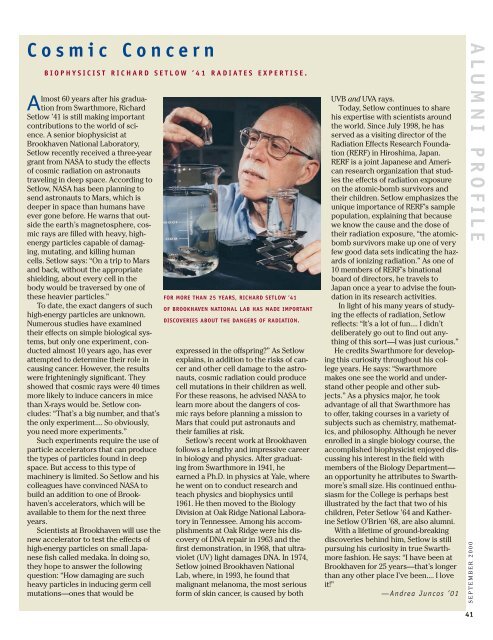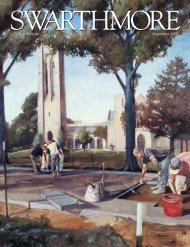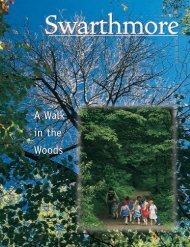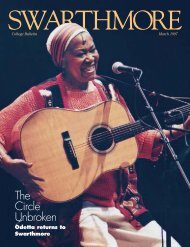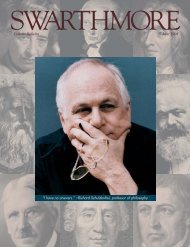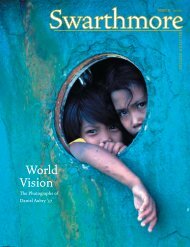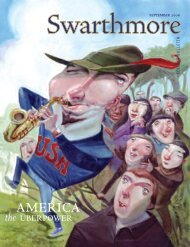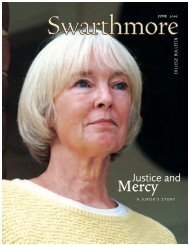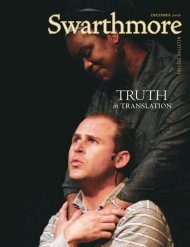SWARTHMORE
Swarthmore College Bulletin (September 2000) - ITS
Swarthmore College Bulletin (September 2000) - ITS
- No tags were found...
You also want an ePaper? Increase the reach of your titles
YUMPU automatically turns print PDFs into web optimized ePapers that Google loves.
C o s m i cAlmost 60 years after his graduationfrom Swarthmore, RichardSetlow ’41 is still making importantcontributions to the world of science.A senior biophysicist atBrookhaven National Laboratory,Setlow recently received a three-yeargrant from NASA to study the effectsof cosmic radiation on astronautstraveling in deep space. According toSetlow, NASA has been planning tosend astronauts to Mars, which isdeeper in space than humans haveever gone before. He warns that outsidethe earth’s magnetosphere, cosmicrays are filled with heavy, highenergyparticles capable of damaging,mutating, and killing humancells. Setlow says: “On a trip to Marsand back, without the appropriateshielding, about every cell in thebody would be traversed by one ofthese heavier particles.”To date, the exact dangers of suchhigh-energy particles are unknown.Numerous studies have examinedtheir effects on simple biological systems,but only one experiment, conductedalmost 10 years ago, has everattempted to determine their role incausing cancer. However, the resultswere frighteningly significant. Theyshowed that cosmic rays were 40 timesmore likely to induce cancers in micethan X-rays would be. Setlow concludes:“That’s a big number, and that’sthe only experiment.... So obviously,you need more experiments.”Such experiments require the use ofparticle accelerators that can producethe types of particles found in deepspace. But access to this type ofmachinery is limited. So Setlow and hiscolleagues have convinced NASA tobuild an addition to one of Brookhaven’saccelerators, which will beavailable to them for the next threeyears.Scientists at Brookhaven will use thenew accelerator to test the effects ofhigh-energy particles on small Japanesefish called medaka. In doing so,they hope to answer the followingquestion: “How damaging are suchheavy particles in inducing germ cellmutations—ones that would beC o n c e r nB I O P H Y S I C I S T R I C H A R D S E T L O W ’ 4 1 R A D I A T E S E X P E R T I S E .FOR MORE THAN 25 YEARS, RICHARD SETLOW ’41OF BROOKHAVEN NATIONAL LAB HAS MADE IMPORTANTDISCOVERIES ABOUT THE DANGERS OF RADIATION.expressed in the offspring?” As Setlowexplains, in addition to the risks of cancerand other cell damage to the astronauts,cosmic radiation could producecell mutations in their children as well.For these reasons, he advised NASA tolearn more about the dangers of cosmicrays before planning a mission toMars that could put astronauts andtheir families at risk.Setlow’s recent work at Brookhavenfollows a lengthy and impressive careerin biology and physics. After graduatingfrom Swarthmore in 1941, heearned a Ph.D. in physics at Yale, wherehe went on to conduct research andteach physics and biophysics until1961. He then moved to the BiologyDivision at Oak Ridge National Laboratoryin Tennessee. Among his accomplishmentsat Oak Ridge were his discoveryof DNA repair in 1963 and thefirst demonstration, in 1968, that ultraviolet(UV) light damages DNA. In 1974,Setlow joined Brookhaven NationalLab, where, in 1993, he found thatmalignant melanoma, the most seriousform of skin cancer, is caused by bothUVB and UVA rays.Today, Setlow continues to sharehis expertise with scientists aroundthe world. Since July 1998, he hasserved as a visiting director of theRadiation Effects Research Foundation(RERF) in Hiroshima, Japan.RERF is a joint Japanese and Americanresearch organization that studiesthe effects of radiation exposureon the atomic-bomb survivors andtheir children. Setlow emphasizes theunique importance of RERF’s samplepopulation, explaining that becausewe know the cause and the dose oftheir radiation exposure, “the atomicbombsurvivors make up one of veryfew good data sets indicating the hazardsof ionizing radiation.” As one of10 members of RERF’s binationalboard of directors, he travels toJapan once a year to advise the foundationin its research activities.In light of his many years of studyingthe effects of radiation, Setlowreflects: “It’s a lot of fun.... I didn’tdeliberately go out to find out anythingof this sort—I was just curious.”He credits Swarthmore for developingthis curiosity throughout his collegeyears. He says: “Swarthmoremakes one see the world and understandother people and other subjects.”As a physics major, he tookadvantage of all that Swarthmore hasto offer, taking courses in a variety ofsubjects such as chemistry, mathematics,and philosophy. Although he neverenrolled in a single biology course, theaccomplished biophysicist enjoyed discussinghis interest in the field withmembers of the Biology Department—an opportunity he attributes to Swarthmore’ssmall size. His continued enthusiasmfor the College is perhaps bestillustrated by the fact that two of hischildren, Peter Setlow ’64 and KatherineSetlow O’Brien ’68, are also alumni.With a lifetime of ground-breakingdiscoveries behind him, Setlow is stillpursuing his curiosity in true Swarthmorefashion. He says: “I have been atBrookhaven for 25 years—that’s longerthan any other place I’ve been.... I loveit!”—Andrea Juncos ’01A L U M N I P R O F I L ES E P T E M B E R 2 0 0 041


